NVIDIA GeForce GTX 780 Ti in 2-way SLI: Performance Review

A set of two high-end graphics cards must be a great performer. We had tested SLI setup of two GeForce GTX 780 Ti and now we can tell about our decision. Is this configuration a good choice from price-performance point of view? Where is hidden dangers of it? Read the review!
Having tested three original GeForce GTX 780 Ti graphics cards from Zotac, MSI and Inno3D, we couldn’t help checking them out in SLI configurations. We were not able to combine all of them into a single subsystem though, just because we only had two of them at one time. Testing a 3-way SLI configuration (with a 3-monitor setup) is still on our plans, but today we want to share with you the results of our testing a SLI configuration built out of two GTX 780 Ti cards in comparison with five opponents, two of which are dual-GPU solutions.
Testbed and Methods
Here is the list of components we use in our testbed.
- Mainboard: Intel Siler DX79SR (Intel X79 Express, LGA 2011, BIOS 0590 dated 17.07.2013)
- CPU: Intel Core i7-3970X Extreme Edition 3.5/4.0 GHz (Sandy Bridge-E, C2, 1.1 V, 6x256KB L2 cache, 15MB L3 cache)
- CPU cooler: Phanteks PH-TC14PЕ (2xCorsair AF140 fans, 900 RPM)
- Thermal grease: ARCTIC MX-4
- Graphics cards:
- AMD Radeon HD 7990 (2x3GB, 1100/6300 MHz)
- Nvidia GeForce GTX 690 (2x2GB, 1006-1111/7208 MHz)
- Nvidia GeForce GTX Titan (6GB, 837-876/6008 MHz and 1006-1045/7200 MHz)
- Inno3D iChill GeForce GTX 780 Ti HerculeZ X3 Ultra (3GB, 1006-1072/7200 MHz)
- Nvidia GeForce GTX 780 Ti (3GB, 1006-1058/7200 MHz)
- ASUS ROG MARS 760 (2x2GB, 1006-1072/6008 MHz)
- AMD Radeon R9 290X (4GB, 1000/5000 MHz)
- System memory: DDR3 4x8GB G.SKILL TridentX F3-2133C9Q-32GTX (XMP: 2133 MHz, 9-11-11-31, 1.6 volts)
- System disk: SSD 256GB Crucial m4 (SATA 6 Gbit/s, CT256M4SSD2, BIOS v0009)
- Games/software disk: Western Digital VelociRaptor (SATA-2, 300 GB, 10000 RPM, 16 MB cache, NCQ) in a Scythe Quiet Drive 3.5″ enclosure
- Backup disk: Samsung Ecogreen F4 HD204UI (SATA-2, 2 TB, 5400 RPM, 32 MB cache, NCQ)
- Sound card: Auzen X-Fi HomeTheater HD
- Computer case: Antec Twelve Hundred (front panel: three Noiseblocker NB-Multiframe S-Series MF12-S2 fans at 1020 RPM; back panel: two Noiseblocker NB-BlackSilentPRO PL-1 fans at 1020 RPM; top panel: one preinstalled 200mm fan at 400 RPM)
- Control & monitoring panel: Zalman ZM-MFC3
- Power supply: Corsair AX1200i (1200 W), 120mm fan
- Monitor: 27″ (DVI-I, 2560×1440, 60 Hz)
Our SLI configuration was built out of a reference GeForce GTX 780 Ti (in the mainboard’s top PCIe slot) and an original GTX 780 Ti from Inno3D:
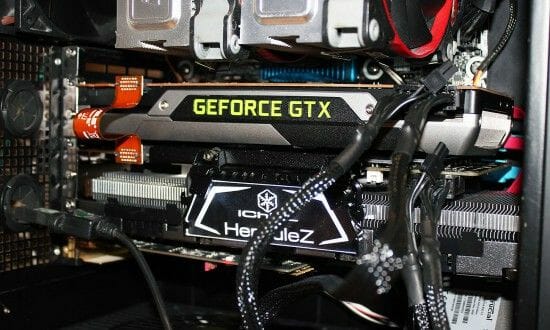
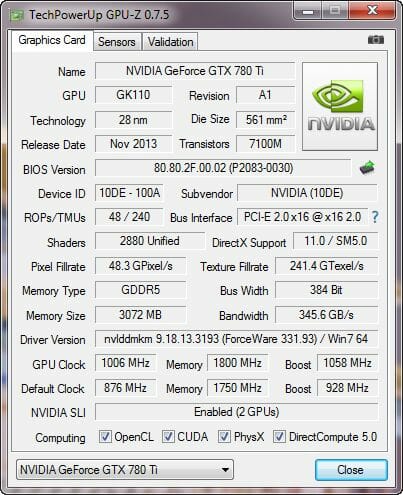
The clock rates of the reference 780 Ti are increased to those of the Inno3D. Two dual-GPU cards from AMD and Nvidia are included into this testing for the comparison’s sake:
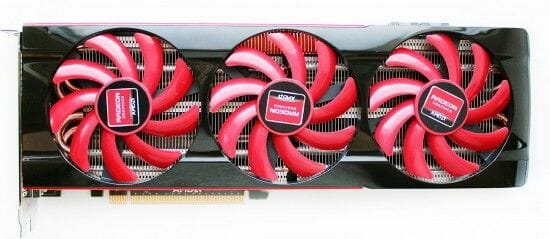
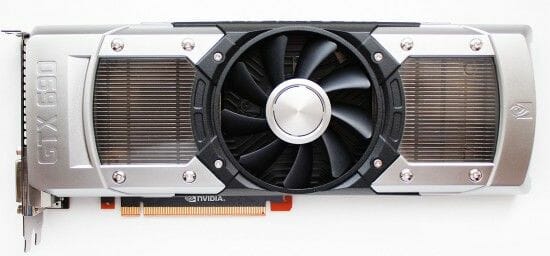
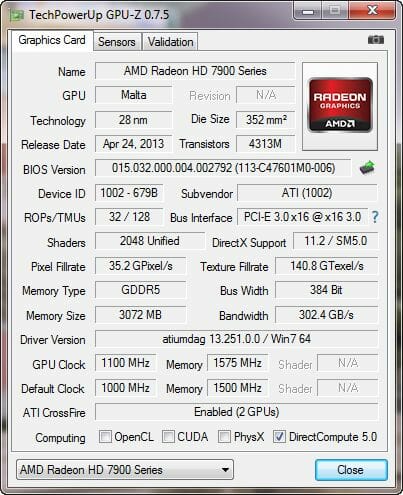
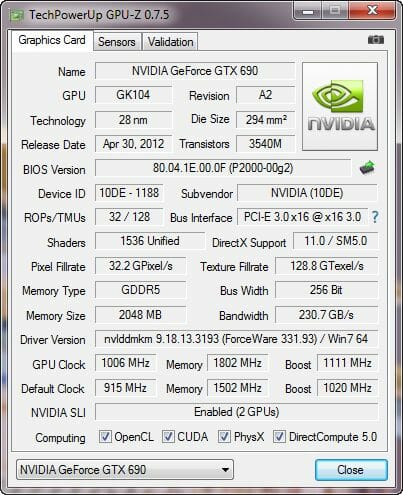
Their GPUs are overclocked by about 100 MHz. The memory clock rate of the Radeon HD 7990 is increased to the maximum of 6300 MHz. The memory frequency of the GeForce GTX 690 is set at 7200 MHz, the same as with the GTX 780 Ti configuration.
Besides the dual-GPU solutions, we also include an Nvidia GeForce GTX Titan 6GB (at 1006-1045/7200 MHz) and an AMD Radeon R9 290X 4GB (at its default clock rates and 70% fan speed to avoid GPU throttling).
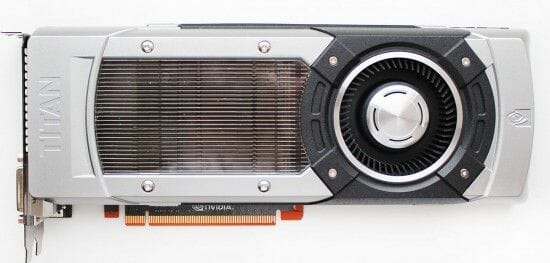
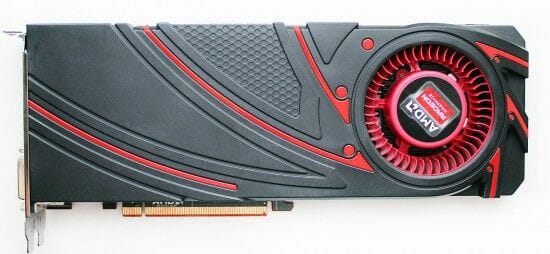
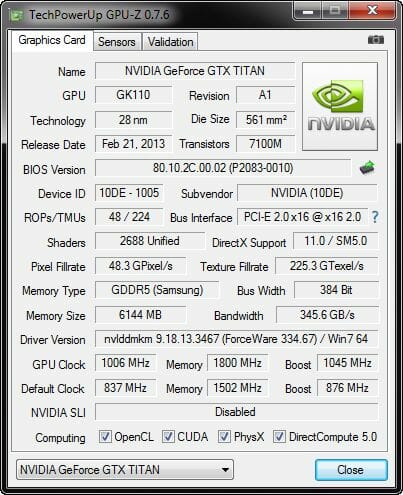
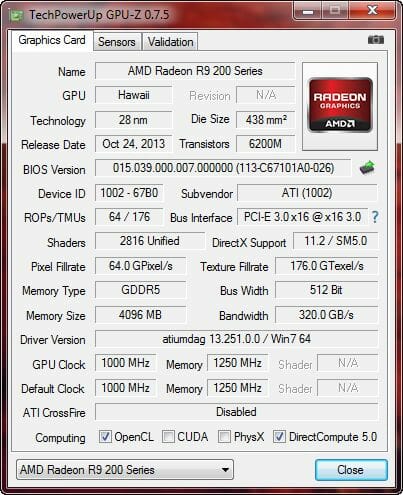
So, we’ve got quite a comprehensive selection of graphics solutions. We only miss a CrossFireX tandem based on Radeon R9 290X cards but their availability is still low, so we have to postpone such testing for now.
Besides the abovementioned cards, we also have a dual-processor ASUS ROG MARS 760 2x2GB working at its default clock rates:
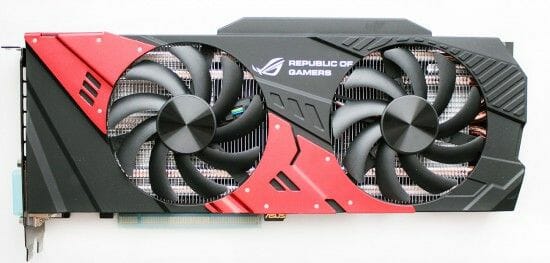
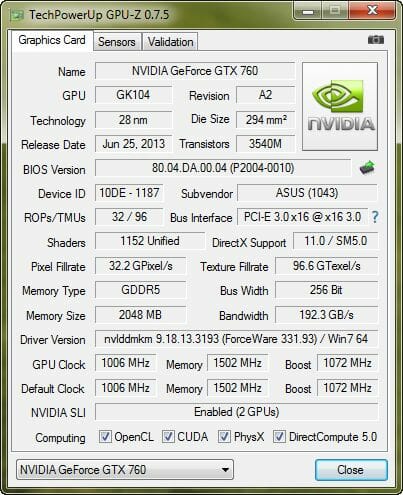
This model is no competitor to the GeForce GTX 780 Ti and we have already compared it with the other cards, yet it will help make our picture more complete.
In order to lower the dependence of the graphics cards’ performance on the overall platform speed, we overclocked our 32nm six-core CPU to 4.8 GHz by setting its frequency multiplier at x48 and enabling Load-Line Calibration. The CPU voltage was increased to 1.38 volts in the mainboard’s BIOS:
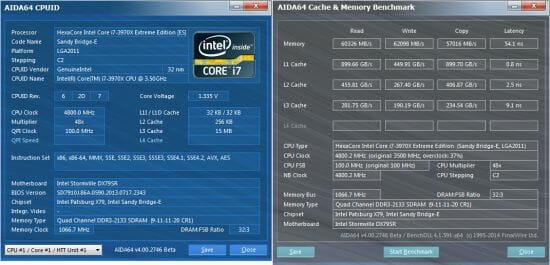
Hyper-Threading was turned on. We used 32 GB of system memory at 2.133 GHz with timings of 9-11-11-20_CR1 and voltage of 1.6125 volts.
The testbed ran Microsoft Windows 7 Ultimate x64 SP1 with all critical updates installed. We used the following drivers:
- Intel Chipset Drivers – 9.4.4.1006 WHQL dated 21.09.2013
- DirectX End-User Runtimes, dated 30 November 2010
- AMD Catalyst 13.12 WHQL (13.251.0.0) dated 18.12.2013
- Nvidia GeForce 331.93 Beta from 27.11.2013 for the GeForce GTX series and GeForce 334.67 Beta from 27.01.2014 for the GeForce GTX Titan
We benchmarked the graphics cards’ performance at two display resolutions: 1920×1080 and 2560×1440 pixels. There were two visual quality modes: “Quality+AF16x” means the default texturing quality in the drivers + 16x anisotropic filtering whereas “Quality+ AF16x+MSAA 4x(8x)” means 16x anisotropic filtering and 4x or 8x antialiasing. In some games we use antialiasing algorithms other than MSAA as indicated below and in the diagrams. We enabled anisotropic filtering and full-screen antialiasing from the game’s menu. If the corresponding options were missing, we changed these settings in the Control Panels of the Catalyst and GeForce drivers. We also disabled Vsync there. There were no other changes in the driver settings.
The graphics cards were tested in two benchmarks and 13 games updated to the latest versions.
- 3DMark (2013) (DirectX 9/11) – version 1.2.250.0: Cloud Gate, Fire Strike and Fire Strike Extreme scenes.
- Unigine Valley Bench (DirectX 11) – version 1.0: maximum visual quality settings, 16x AF and/or 4x MSAA, 1920х1080.
- Total War: SHOGUN 2 – Fall of the Samurai (DirectX 11) version 1.1.0: integrated benchmark (the Sekigahara battle) with maximum visual quality settings and 8x MSAA.
- Sniper Elite V2 Benchmark (DirectX 11) – version 1.05: we used Adrenaline Sniper Elite V2 Benchmark Tool v1.0.0.2 BETA with maximum graphics quality settings (“Ultra” profile), Advanced Shadows: HIGH, Ambient Occlusion: ON, Stereo 3D: OFF, Supersampling: OFF, two sequential runs of the test.
- Sleeping Dogs (DirectX 11) – version 1.5: we used Adrenaline Sleeping Dogs Benchmark Tool v1.0.2.1 with maximum image quality settings, Hi-Res Textures pack installed, FPS Limiter and V-Sync disabled, two consecutive runs of the built-in benchmark with quality antialiasing at Normal and Extreme levels.
- Hitman: Absolution (DirectX 11) version 1.0.447.0: built-in test with Ultra settings, enabled tessellation, FXAA and global lighting.
- Crysis 3 (DirectX 11) – version 1.2.0.1000: maximum visual quality settings, Motion Blur – Medium, lens flares – on, FXAA and MSAA 4x, two consecutive runs of a scripted scene from the beginning of the “Swamp” mission (110 seconds long).
- Tomb Raider (2013) (DirectX 11) – version 1.1.748.0: we used Adrenaline Benchmark Tool, all image quality settings set to “Ultra”, V-Sync disabled, FXAA and 2x SSAA antialiasing enabled, TessFX technology activated, two consecutive runs of the in-game benchmark.
- BioShock Infinite (DirectX 11) – version 1.1.24.21018: we used Adrenaline Action Benchmark Tool with “Ultra” and “Ultra+DOF” quality settings, two consecutive runs of the in-game benchmark.
- Metro: Last Light (DirectX 11) version 1.0.0.15: we used the built-in benchmark for two consecutive runs of the D6 scene. All image quality and tessellation settings were at “Very High”, Advanced PhysX technology enabled, with and without SSAA antialiasing.
- GRID 2 (DirectX 11) – version 1.0.85.8679: we used the built-in benchmark, the visual quality settings were all at their maximums, the tests were run with and without MSAA 8x antialiasing with eight cars on the Chicago track.
- Company of Heroes 2 (DirectX 11) – version 3.0.0.11811: two consecutive runs of the integrated benchmark at maximum image quality and physics effects settings.
- Total War: Rome II (DirectX 11) version 1.8.0 build 8891.481024: Extreme quality, V-Sync disabled, SSAA enabled, two consecutive runs of the integrated benchmark.
- Batman: Arkham Origins (DirectX 11) version 1.0 update 8: Ultra visual quality, V-Sync disabled, all the effects enabled, all DX11 Enhanced features enabled, Hardware Accelerated PhysX = Normal, two consecutive runs of the in-game benchmark.
- Battlefield 4 (DirectX 11) – version 1.4: Ultra settings, two successive runs of a scripted scene from the beginning of the “Tashgar” mission (110 seconds long).
We publish the bottom frame rate for games that report it. Each test was run twice, the final result being the best of the two if they differed by less than 1%. If we had a larger difference, we reran the test at least once again to get repeatable results.
Performance
The results of the 2-way SLI configuration (built out of two GeForce GTX 780 Ti cards) and of both dual-GPU cards from Nvidia are indicated in turquoise. The single-GPU GeForce GTX cards are green and the AMD-based cards are red.
Considering the high performance and price ($1500 and more) of the GeForce GTX 780 Ti tandem, we’re going to focus on the resource-consuming mode (2560×1440 with different types of antialiasing). We guess no one would build such an advanced graphics subsystem to play at a resolution lower than 2560×1440 and without AA. Still, the diagrams show all of our test results.
3DMark (2013)
The GeForce GTX 780 Ti SLI tandem is up to 70% efficient at the highest settings, outperforming its closest opponent, the dual-processor Nvidia GeForce GTX 690, by 51%. So we seem to have built a very fast SLI configuration…
Unigine Valley Bench
The GeForce GTX 780 Ti is the same 75% faster than the single such card in Unigine Valley as well. The difference from the GeForce GTX 690 is smaller than in 3DMark (2012) at 42%.
Total War: SHOGUN 2 – Fall of the Samurai
This game’s engine runs smoothly on multi-GPU configurations, both Nvidia SLI and AMD CrossFireX. Here’s yet another proof:
Although the game is nearly 3 years old, it is still a heavy load even for top-end graphics solutions at 2560×1440 with maximum visual quality settings. The two GeForce GTX 780 Ti in SLI mode show their best here, beating the single GTX 780 Ti by 86% and the dual-processor GTX 690 by 48%!
Sniper Elite V2 Benchmark
The 2-way SLI tandem built out of GeForce GTX 780 Ti cards is impressive in this game, too.
The two GTX 780 Ti cards are 85% faster than the single GTX 780 Ti and 45% faster than the second-best GTX 690. The bottom speed is rather low with each of the tested graphics solutions, though.
Sleeping Dogs
Top-end graphics solutions can only show their full power in the most resource-consuming test mode here.
At 2560×1440 with high-level antialiasing the two GeForce GTX 780 Ti cards are as much as 82% ahead of the single GTX 780 Ti and also beat the Nvidia GeForce GTX 690 (by 47%) and AMD Radeon HD 7990 (by 78%).
Hitman: Absolution
Although a CPU-dependent game, Hitman: Absolution benefits from enabling SLI on our two top-end graphics cards.
The two GK110-based cards are up to 79% faster than the single such card here. As opposed to the previous tests, the AMD Radeon HD 7990 is second, outpacing the GeForce GTX 690. It is still 47% slower than the leader, though.
Crysis 3
This is such a heavy application that the effect from adding a second GeForce GTX 780 Ti can be seen in every test mode and at every display resolution.
It is at 2560×1440 with 4x MSAA that the SLI tandem enjoys its biggest advantage over the single card – up to 85%. It is also 47% ahead of the dual-processor Nvidia GeForce GTX 690 and 69% ahead of the AMD Radeon HD 7990.
Tomb Raider (2013)
We see the same picture here as in the previous test.
The SLI tandem ensures performance benefits in every test mode, its maximum efficiency amounting to 90% (one of the best results in this test session). The dual-processor cards are both 50-60% behind the leader.
BioShock Infinite
Like all single-GPU Nvidia-based products, the 2-way GeForce GTX 780 Ti SLI configuration has a very low bottom speed in this game. The AMD-based cards aren’t much better in this respect, though.
The SLI technology is less efficient in BioShock Infinite than in the three previous benchmarks. Anyway, the two GeForce GTX 780 Ti cards are faster than the single such card by up to 72% and also beat the GeForce GTX 690 (by 44%) and Radeon HD 7990 (by 52%).
Metro: Last Light
First, let’s check out the cards with the Advanced PhysX option turned on.
The SLI technology has always been rather inefficient in this game, yet the two GeForce GTX 780 Ti turn out to be 68% faster than the single card. The SLI tandem is also 50% ahead of the GTX 690 and twice as fast as the Radeon HD 7990.
AMD’s Radeon HD 7990 and R9 290X feel much better with the extra physics effects turned off, though.
Anyway, the GeForce GTX 780 Ti tandem is up to 56% ahead of the dual-processor solutions. Like in the resource-consuming Crysis 3, our top-end SLI configuration helps make the gameplay much smoother.
GRID 2
One GeForce GTX 780 Ti is quite enough to ensure a high frame rate in GRID 2. That’s why adding a second card only improves performance by 55% at best. The SLI tandem is only 12-36% ahead of the GeForce GTX 690 and 5-28% ahead of the AMD Radeon HD 7990.
Company of Heroes 2
To see the effect from the SLI technology in this game, we need to choose the maximum visual quality settings.
So, at 2560×1440 with maximum antialiasing the GeForce GTX 780 Ti SLI tandem is 80% faster than the single GTX 780 Ti, 80% faster than the GeForce GTX 690 and 64% faster than the AMD Radeon HD 7990. Why? Well, this game doesn’t work well with multi-GPU technologies, so you have to enable AFR mode and put up with screen flickering. Of course, the frame rate goes up, but the game becomes downright unplayable. There is no point in building a SLI tandem out of two GeForce GTX 780 Ti cards for Company of Heroes 2.
Total War: Rome II
Our SLI tandem is useless in this game, too.
Batman: Arkham Origins
The 2-way GeForce GTX 780 Ti SLI can ensure a 73% performance boost over the single GTX 780 Ti in the most resource-consuming mode of this game. It is also far ahead of the dual-processor cards here.
Battlefield 4
The two GeForce GTX 780 Ti cards in SLI mode aren’t very fast even at 2560×1440 with 4x antialiasing.
Our SLI tandem is only up to 34% faster than the single GTX 780 Ti. It also beats the GeForce GTX 690 and barely outperforms the AMD Radeon HD 7990. The developers of the GeForce driver (or of the game itself) seem to have some work to do yet.
Performance Summary
Let’s check out the efficiency of Nvidia’s multi-GPU technology first. Here’s the 2-way SLI tandem compared to the single GeForce GTX 780 Ti at the same clock rates.
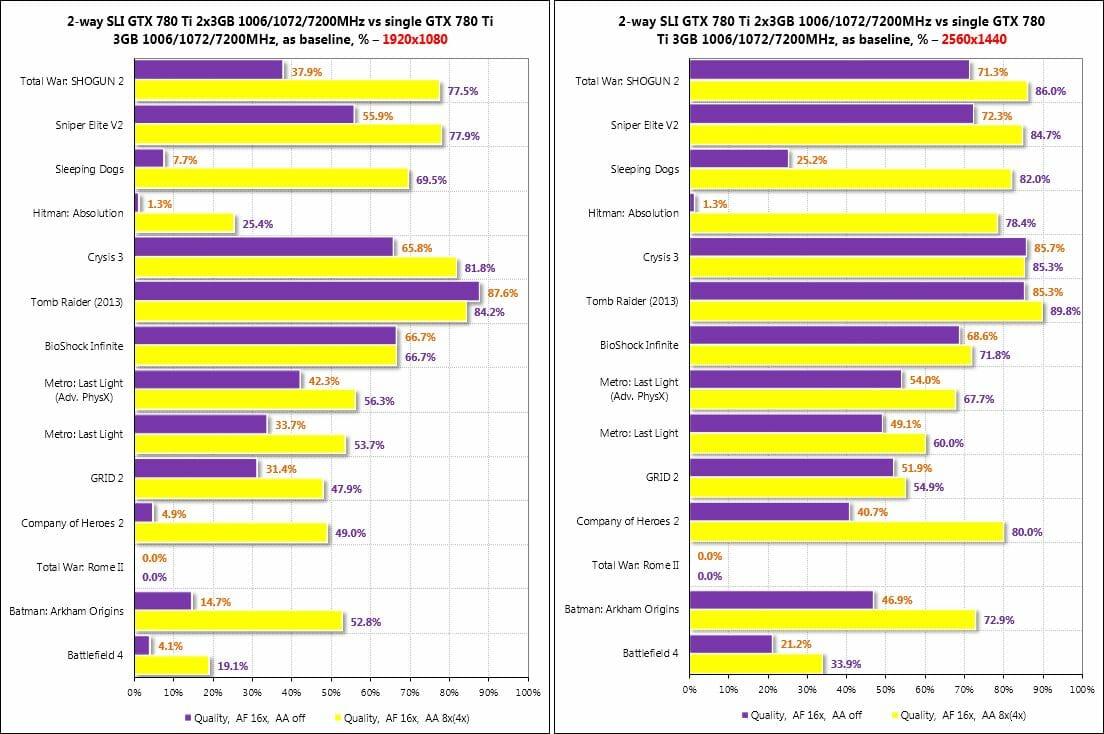
Depending on the resolution and visual quality settings, adding a second GeForce GTX 780 Ti card may ensure a performance boost up to 90%, if the game is supported properly by the graphics driver. So when everything works smoothly, the performance gain is almost twofold. On the other hand, there are cases where the SLI technology is inefficient or doesn’t work at all. It depends on the particular game whether building such a tandem is worthwhile.
Next, we compare the two GeForce GTX 780 Ti cards with the dual-processor GeForce GTX 690. Both use the same driver and SLI technology.
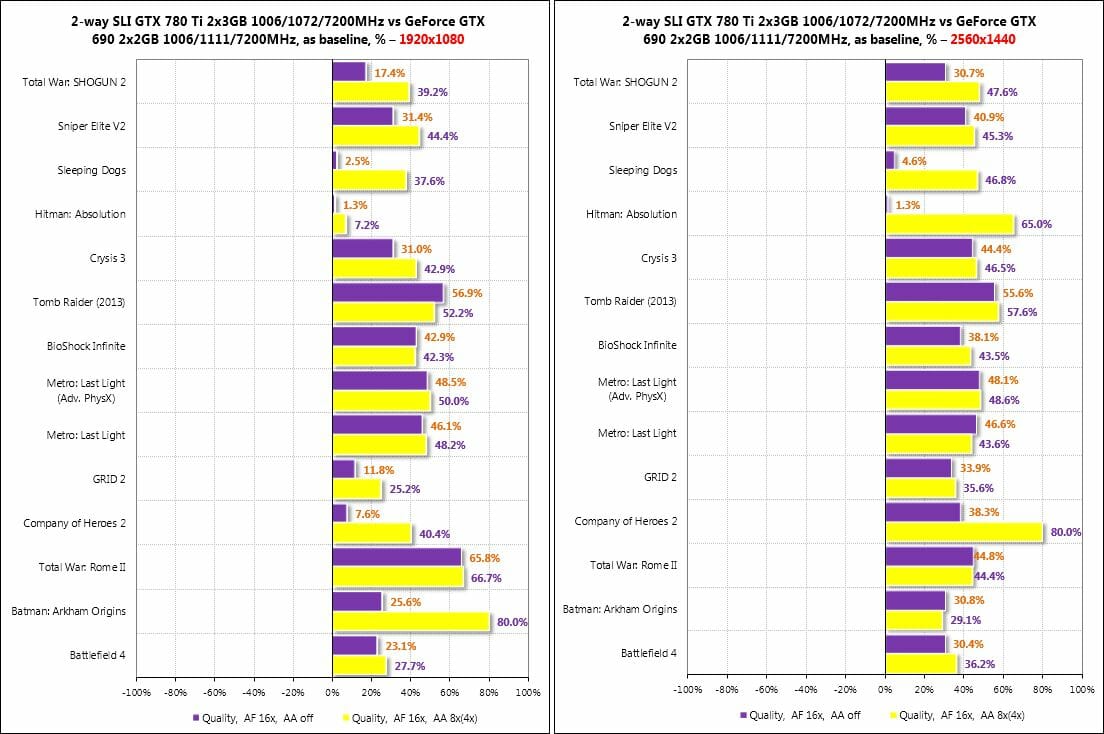
Except for a few games, the 2-way GeForce GTX 780 Ti SLI is much faster than the GeForce GTX 690. The average gap is 48% at the high visual quality settings.
The SLI tandem is also an average 56% ahead of the AMD Radeon HD 7990 at the same settings:
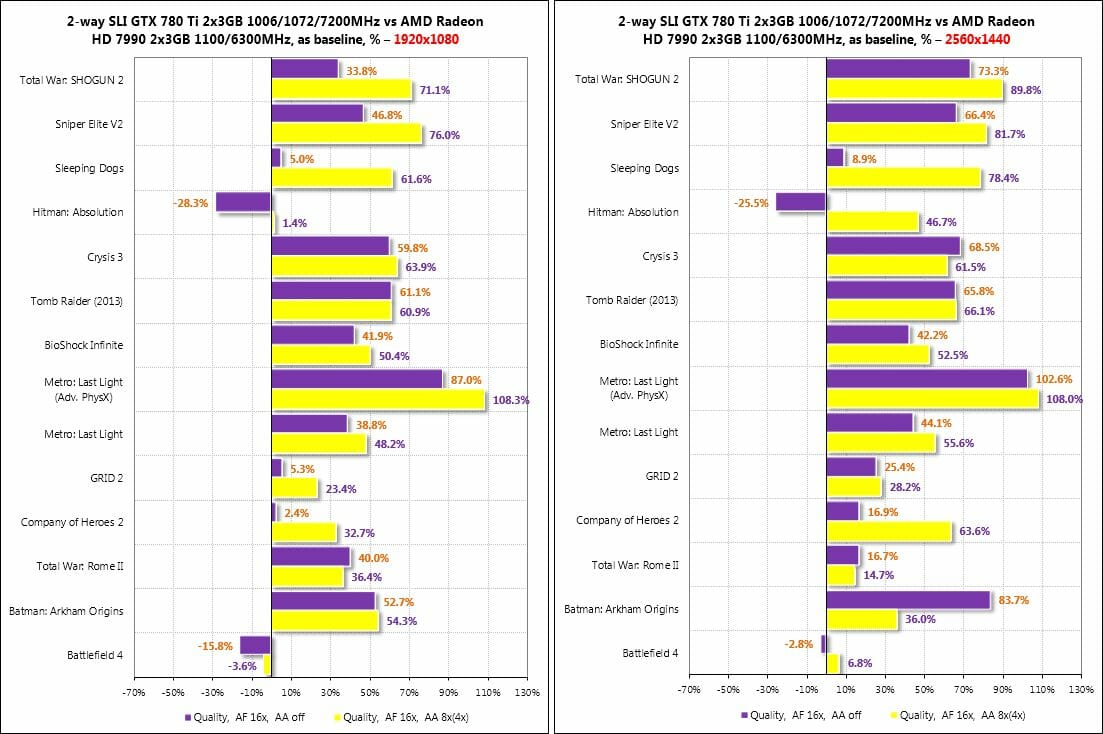
The SLI configuration loses a couple of tests either because the game is limited by the speed of the platform (Hitman: Absolution) or doesn’t work smoothly with SLI (Battlefield 4). Overall, the 2-way GeForce GTX 780 Ti SLI enjoys a larger advantage over the AMD Radeon HD 7990 than over the GeForce GTX 690.
Power Consumption
We measured the power consumption of computer systems with different graphics cards using a multifunctional panel Zalman ZM-MFC3 which can report how much power a computer (the monitor not included) draws from a wall socket. There were two test modes: 2D (editing documents in Microsoft Word and web surfing) and 3D (the intro scene of the Swamp level from Crysis 3 running four times in a loop at 2560×1440 with maximum visual quality settings but without MSAA). Here are the results.
The computer with our 2-way GeForce GTX 780 Ti SLI configuration needs about 800 watts of power at peak loads, so you’d need at least a 850W PSU for it. This is 116 watts more than required by the computer with an overclocked AMD Radeon HD 7990. The Nvidia GeForce GTX 690 system needs 144 watts less and the system with one GeForce GTX 780 Ti (working at the same clock rates) needs 217 watts less.
Conclusion
A SLI tandem built out of two GeForce GTX 780 Ti cards is one of the fastest graphics subsystems available today and is perfect for the most resource-consuming games and benchmarks. It will cost you about as much money as a whole midrange PC but its graphics performance is going to be unprecedented. It is only necessary for the game to support SLI technology and for the Nvidia GeForce driver to have appropriate optimizations. Of course, as is always the case with products of such a high class, you need a high-performance platform, a high-wattage PSU and a roomy computer case. In the best scenario, the two GeForce GTX 780 Ti will almost double the frame rate of a single such card. Crysis 3, Metro: Last Light and Tomb Raider indicate that such an advanced graphics subsystem won’t be overkill. So if you can afford a couple of GTX 780 Ti cards and prefer premium-quality graphics, you should certainly try combining them into a 2-way SLI tandem.